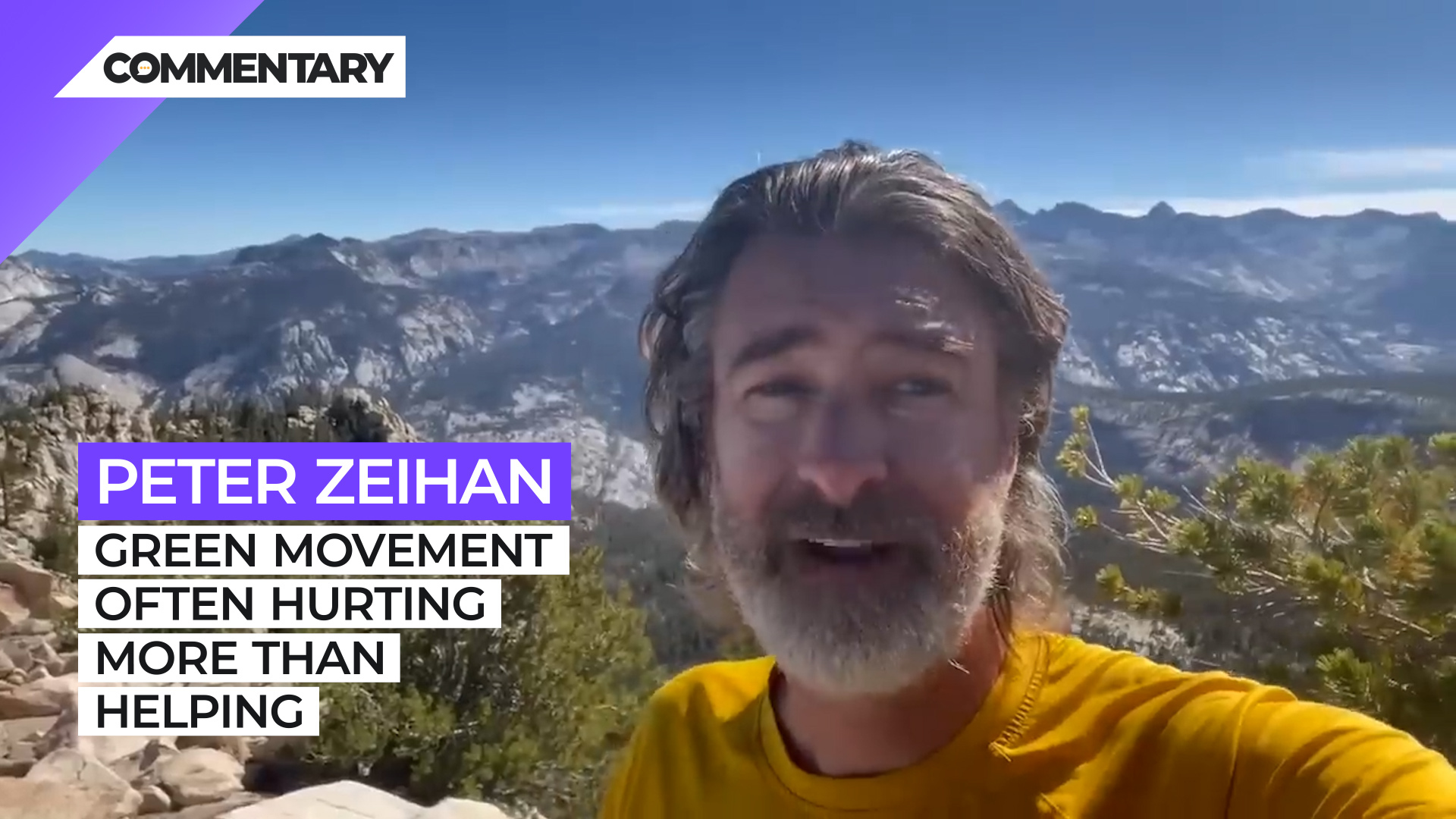
Commentary
-
Our commentary partners will help you reach your own conclusions on complex topics.
Hi everyone, Peter Zeihan here coming to you from Central Yosemite just south of Quartzite Peak. This is a very difficult place to get to, in my opinion, the view makes it worth it. But it’s two days of off trail travel in the most rugged parts of the park.
Let’s talk about something else that we hope is worth it. And that is green tech, solar and wind, particularly. Now, photovoltaic cells are…they’re heralded as a cure-all. The idea is you can put them anywhere, get a little bit of juice from the sun, it’s better than any sort of fossil fuels, and that is total and absolute crap. The process for producing PVs is extraordinarily damaging to the environment, if it’s done wrong. And even if it’s done right, it’s a bit of a question as to whether or not you can put the panels in the right place.
Now, the silicon that goes into the PV panels themselves is not hard to get. Silicon is one of the more common elements and you can mine quartz in a lot of places. Then there are a half a dozen places that can refine it into solar-grade silicon. However, that process basically involves a blast furnace. And if you’re doing this in China, which is where nearly half of it is done, you’re talking about doing it with coal. So already the carbon footprint for the process is extreme.
And then, most of the assembly for the panels is done in China as well, usually in places like Ji-jang, where it’s done by slave labor. So already you got all these things that are kind of stacking up against solar right from the get go. Now, this is all okay, right, if you’re able to get an environmental benefit on the back end. Well, there are a lot of places in the world that are not particularly sunny. And most of those are places where we have our big cities.
So for example, here I am in the highlands of the Sierras. If I was to put panels here, they’d do really well. We’re at high elevation, they have a lot of long sun days, it would be fine. Unfortunately, not a lot of people live here. Take those same panels and you move them to Seattle, or Toronto, or New York, or Boston or London, or Copenhagen, or Stockholm, or Shanghai, or Hong Kong, and they’re going to generate less than 1/5 the amount of electricity.
So whatever, you’re willing to suck up on the front end, you need those panels to run five times as long in order to make good. And in most of those cities that I listed, that means you will never break even on just the carbon debt, to say nothing of the trade issues, or the human rights issues.
Now, does that mean that solar is pointless, you can’t put it anywhere? Of course not. If you’re put in a sunny place, say Albuquerque, New Mexico, where I live in Denver, Durban, South Africa, most places in say, Italy or Greece, there are a lot of places where it makes a lot of sense. But there are far more where it makes none whatsoever. And then of course, there’s a transmission issue.
You don’t put panels in New York, because it’s too densely populated. You have to put them outside of the city. And if you want to put them outside the city far enough away that they actually generate a meaningful trickle of power, you’re talking then about wiring it at least 500 miles. And now you have another issue with transmission and all the things that go with that.
So that’s solar. Wind, much better.
There’s nothing toxic involved in the manufacturing. A lot of the manufacturing is either done in the United States or in Denmark, using some sort of carbon fiber and then some aluminum. There is a carbon footprint to both of those, but it’s nothing compared to what you have to do for silicon. And unlike solar, which seems to have this mystique, wind doesn’t. No one thinks that they should put wind turbines where it’s not windy. But people think that they should put solar panels where it’s not sunny.
And so wind turbines are only going up in places that it makes sense. So American Great Plains are great. For example, there’s some places in California that are good. In the case of Europe, anywhere in the vicinity of the North Sea looks great. The Danes get about half of their power from wind. And then there are a number of places around the world that look good as well.
There’s still the problem of co-locating that production with population centers, but it’s not nearly as messy in the case of wind because we’re now seeing a technological advance with wind.
It used to be that the turbines were only 100 feet tall. And so unless you had wind right there on the ground, it didn’t make much sense. But as our engineering has improved, it’s under 200, 300 to now almost 800 feet. And that means there’s larger parts of the planet. We’ve seen like a quadrupling of zones of the planet where wind now makes sense. And as you reach higher, something else happens. You tap wind currents that are not just stronger, that are more reliable. I’m gonna rotate a little bit here so you can see more of the view. That’s where I went like four years ago. Anyway.
Because of that, for per dollar invested in wind versus solar, you’re going to generate about three to four times as much electricity. In addition, those stronger, more reliable currents can now start to be used for baseload capacity, which is really important. One of the problems we have with wind versus solar and wind versus solar versus everything else is intermittency. Obviously, the wind doesn’t always blow and there has never been one iota of solar energy generated after sunset. And yet, prime demand in most cities in the world is after 6pm for electricity. And that means solar can never be part of peak demand. But now wind can.
So not only you’re getting that three or four to one price difference in terms of solar versus wind, wind is actually more useful overall, because the wind can burn…I’m sorry, the wind can blow at times when we need the power the most.
Now, the problem we have is that everyone is believing this mystique on solar and so in most populated zones in most of the planet, solar has become part of the environmental problem rather than part of the solution. And until we can get past that until we can actually match technologies to locations, the Green Movement is actually in many cases, causing more damage than help. Except for wind. Wind is great. Okay, that’s it for me. Until next time.
-
Hurricane Helene hits US coast, Appalachia and beyond
Hurricane Helene hit Florida and Georgia overnight between Sept. 26 and 27 as a Category 4 hurricane, and accompanying storms will continue reaching deeper into the continental United States today. Dangerous flash flooding from the hurricane, known as storm surge, was some of the worst flooding that the Tampa Bay area has ever seen, and… -
Israel holds upper hand against Lebanon, Hezbollah and Iran
On Wednesday, Sept. 25, Hezbollah launched a ballistic missile at Tel Aviv in retaliation for Israel’s explosive pager attack that blew up devices across Lebanon. Although Israel’s defense systems intercepted the surface-to-surface missile, the attempted strike on Tel Aviv marked a significant escalation by Hezbollah. Since the siege on Gaza began, shortly after the Oct. 7, 2023,… -
The Sinaloa Cartel civil war
Fears of a civil war within the Sinaloa Cartel are growing as violence between competing factions within the cartel continues. The Mexican Army has dispatched around 600 elite troops to Sinaloa to help quell those fears, in addition to roughly 2,200 regular soldiers and National Guard. Watch the above video as Straight Arrow News contributor… -
New Ukrainian weapons hit Russia where it hurts
Ukrainian drones struck a major Russian ammunition depot, triggering a massive explosion that was captured on camera. According to the Ukrainian military, 2,000 tons of munitions had arrived at the depot before the attack. Over the past two years, Ukraine has significantly increased its domestic drone production, allowing it to scale up attacks on military… -
Weighing social costs vs. economic benefits on immigration
Global human migration is one of the defining elements of our current historical era, according to the United Nations. Migrants face both the incentives to leave — forced out by climate change, crime and corruption, extreme poverty or violence — and incentives for where to go, based on available job opportunities and so on. Migration…
Latest Stories
-
 Getty Images
Getty Images
Trump, Zelenskyy prep to sign minerals deal before address to Congress: Report
-
 Getty Images
Getty Images
Effort to recall Los Angeles Mayor Karen Bass underway after January’s wildfires
-
 Getty Images
Getty Images
TikTok profits from sexual content by teens, sparks safety concerns: Report
-
 Getty Images
Getty Images
States hope to ease medical license laws, solve rural doctor shortage
-
 Getty Images
Getty Images
Supreme Court appears ready to rule for US gun manufacturers sued by Mexico
Popular Opinions
-
In addition to the facts, we believe it’s vital to hear perspectives from all sides of the political spectrum.
Latest Opinions
In addition to the facts, we believe it’s vital to hear perspectives from all sides of the political spectrum. We hope these different voices will help you reach your own conclusions.
The opinions published in this section are solely those of the contributors and do not reflect the views of Straight Arrow News.





















Latest Commentary
We know it is important to hear from a diverse range of observers on the complex topics we face and believe our commentary partners will help you reach your own conclusions.
The commentaries published in this section are solely those of the contributors and do not reflect the views of Straight Arrow News.
Dr. Frank Luntz
Pollster and Political Analyst‘Biased’: What Americans think of ‘mainstream media’
‘Getting rid of them’: Americans discuss Trump and immigration
‘Woke’: Why some Biden 2020 voters backed Trump in 2024